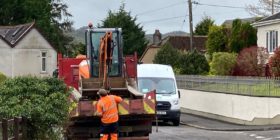Residents of Kidwelly Presented with Flood Protection Options to Combat Rising Waters

A RANGE of flood protection options are being put to residents of Kidwelly after parts of the Carmarthenshire town experienced two bouts of flooding in October, 2021.
In total 41, homes and seven businesses were damaged during the two intense rainfall events, prompting the county council to undertake a detailed investigation.
It concluded that the primary sources of the flooding included small streams, overwhelmed drainage systems and a high volume of surface water emanating in part from fields above.
The council has repaired damage to the banks of a stream called Cae Ffynon and increased the capacity of a culvert, and has now drawn up a longer term plan involving a range of options to slow the peak flow of floodwater. The options include tree-planting, natural dams, water run-off storage areas, earthworks known as bunds, the use of permeable paving and other drainage upgrades.
It’s early days though and Welsh Government funding will be needed for whatever measures end up being approved.
Flooding is not unique to Kidwelly, which has population of around 2,800, but its steep topography is a factor. The town now has a handful of flood representatives from within the community who have been working with the authorities since 2021.
One of the flood representatives is Phillip Hayman, of Ferry Road, whose garden and drive have flooded three times in the 10 years he has lived there.
The third occasion, in October, 2021, was, he said, by far the worst. “It was in the evening, and dark, and it happened all of a sudden,” he said. “I heard a loud explosion – it was the wall of my back garden being demolished.”
He said his neighbour’s back garden had filled up like a “swimming pool”, finally overcoming Mr Hayman’s wall, which was attached to his house. Six months and one insurance claim later the wall was rebuilt, and, fortunately, there was no internal property damage.
Mr Hayman said he and the other flood representatives have walked around the area several times with council officers and councillors to better understand the problem and suggest improvements. “It’s fantastic teamwork,” he said.
Cath Abbott, the council’s programme manager for flood and coastal erosion risk management, said some properties were overcome by two feet of silt-laden floodwater in October 2021, and that climate change was leading to increased rainfall intensity. “It’s devastating for those people,” she said. “You don’t feel secure in your own home.”
She said the problems in Kidwelly were not caused by main rivers – which Natural Resources Wales is responsible for – but smaller watercourses, like streams and culverts, and surface water run-off. Ms Abbott attended a public meeting with posters showing the various mitigation options at Kidwelly’s Princess Gwenllian Centre on February 27. Feedback from the event will help influence the next stage of the project. Criteria such as number of properties protected, cost, maintenance requirements, and benefits for biodiversity will shape final decisions.
Kidwelly resident Crish Davies became a flood representative in 2021 before being elected as a county councillor in May the following year. “It was really helpful having a direct line to council officers,” she said.
Cllr Davies said she had become an expert in drains and ditches, and said the flood representative initiative was being rolled out to nearby Ferryside. “It has been such a successful group,” she said.
Cllr Aled Vaughan Owen, whose cabinet portfolio includes climate change, said: “Tackling the issue of localised flooding requires the input of the local community and I would encourage as many residents as possible to have their say on the development of the options.”
Spotted something? Got a story? Email News@News.Wales










